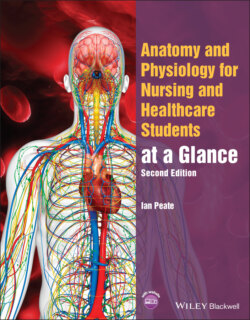Читать книгу Anatomy and Physiology for Nursing and Healthcare Students at a Glance - Ian Peate - Страница 18
Оглавление6 Transport systems
Figure 6.1 Simple diffusion.
Source: Tortora GJ, Derrickson B. Tortora’s Principles of Anatomy and Physiology, 15th edn. Hoboken: Wiley (2017).
Figure 6.2 Channel‐mediated facilitated diffusion of potassium ions (K+) through a gated K+ channel.
Source: Tortora GJ, Derrickson B. Tortora’s Principles of Anatomy and Physiology, 15th edn. Hoboken: Wiley (2017).
Figure 6.3 Osmosis. Water molecules move through the selectively permeable membrane; solute molecules cannot. (a) Water molecules move from the left arm into the right arm, down the water concentration gradient. (b) The volume of water in the left arm has decreased and the volume of solution in the right arm has increased. (c) Pressure applied to the solution in the right arm restores the starting conditions.
Source: (a) Tortora GJ, Derrickson B. (2017) Tortora’s Principles of Anatomy and Physiology, 15th edn. Hoboken: Wiley, (b) David M. Phillips/Science.
Figure 6.4 Tonicity and the red blood cell.
Source: Tortora GJ, Derrickson B. Tortora’s Principles of Anatomy and Physiology, 15th edn. Hoboken: Wiley, with permission from John Wiley & Sons (2017).
Cells perform chemical reactions essential for organism survival. The substances required for these reactions to occur (for example, oxygen and glucose) have to enter the cells and waste products must be removed from the cells. In humans, substances move into and out of cells by osmosis diffusion active transport; plasma membranes are selectively permeable. The cell membrane (see Chapter 5) acts as a gatekeeper, ensuring the cell’s cytoplasm remains in place, and will only permit entry to and allow exit from the cell as needed. Three transport systems will be discussed in this chapter: simple diffusion facilitated diffusion and osmosis.
Simple diffusion
This is a passive process in which substances move freely through the lipid bilayer of the plasma membranes of cells; this does not require the help of membrane transport proteins (Figure 6.1). Through the process of simple diffusion, non‐polar, hydrophobic molecules move across the lipid bilayer; these include oxygen, carbon dioxide, nitrogen gases; fatty acids, steroids and fat‐soluble vitamins. Small, uncharged polar molecules, for example water and urea, also pass through the lipid bilayer by simple diffusion. This type of transport mechanism, occurring through the lipid bilayer, is crucial for the movement of oxygen and carbon dioxide between blood and body cells and also between blood and air occurring within the lungs during breathing. This route is also used for absorption of some nutrients and the excretion of some waste by body cells. While this process occurs spontaneously, the rate of diffusion for different substances is influenced by membrane permeability. It is also influenced by cell properties, the diffusing molecule, temperature of the surrounding solution and the size of the molecule.
Facilitated diffusion
This is a type of diffusion in which molecules are transported across the plasma membrane with the assistance of membrane proteins because the molecules are too polar or highly charged to move through the lipid bilayer by simple diffusion. The molecule to be transported first binds to a receptor site on the carrier protein. The shape of the protein then changes and the molecule is transported into the cell where it is released into the cytoplasm. Once transportation is complete, the protein will then return to its normal shape.
Small non‐polar molecules can be easily diffused across the cell membrane but due to the hydrophobic nature of the lipids making up cell membranes, polar molecules, for example water and ions, cannot. A transport protein completely spans the membrane, permitting certain molecules or ions to diffuse across the membrane. Channel proteins, gated channel proteins and carrier proteins are three types of transport proteins that are involved in facilitated diffusion. See Figure 6.2, depicting channel‐mediated facilitated diffusion of potassium ions (K+) through a gated K+ channel.
Osmosis
Osmosis refers to the movement of solution from an area of high volume to an area of low volume through a selective permeable membrane. It is a type of diffusion (Figure 6.3). Although osmosis does not utilise energy, it uses kinetic energy. The kinetic energy of an object is the energy that it possesses due to its movement. The movement of water driven by osmosis is known as osmotic flow. The greater the initial difference in solute concentrations, the stronger the osmotic flow.
Those solutions with varying solute concentrations are described as isotonic, hypotonic or hypertonic (Figure 6.4). When a cell is placed in an isotonic solution, there is very little net movement of water in or out of the cell. When placed in a hypotonic solution, water will move into the cell, causing it to swell and burst. However, when the cell is placed in a hypertonic solution, water will move out of the cell, causing it to shrink and die.
Endocytosis and exocytosis
Endocytosis is an energy‐using process by which cells absorb molecules (such as proteins) by engulfing them. Endocytosis occurs in three different ways.
1 Phagocytosis: pseudopodia engulf the particle to be imported.
2 Pinocytosis: the cell membrane pinches in to engulf a portion of extracellular fluid containing solutes required by the cell. This process is non‐specific; any solutes in the solution will be engulfed.
3 Receptor‐mediated endocytosis: this process allows the intake of large quantities of molecules that may not be in high concentration in the extracellular fluid.
Exocytosis is the process by which the cell releases materials to the outside by discharging them as membrane‐bound vesicles passing through the cell membrane.
Clinical practice point
While phagocytosis is an effective defence mechanism, some pathogenic species can escape this process, including E. coli and S. aureus. Diminished phagocytosis can lead to the development of autoimmune disorders. Phagocytic function is impaired with age.
